Nothing says fall like pumpkin! We love our pumpkin spice lattes, pumpkin pies, and of course, our jack o’lanterns.
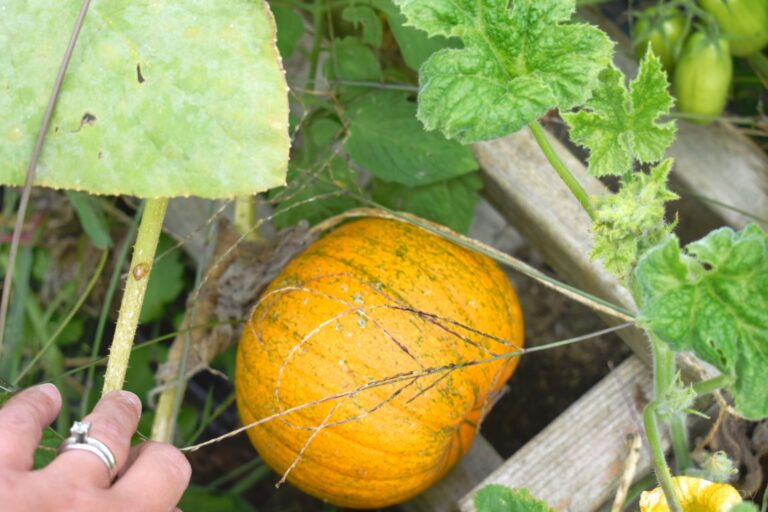
If you love pumpkins, and you enjoy gardening, it might be time to plant, grow, and harvest pumpkins for yourself.
Just imagine having your homegrown pumpkins grace the table at your Thanksgiving dinner. Or perhaps you would enjoy decorating your front porch for Halloween the fruit of your own garden.
Or perhaps you would prefer to have soup or pie that you made yourself from your very own pumpkins. With some simple considerations, pumpkins are easy and enjoyable to grow.
Pumpkins are scientifically considered to be a fruit because the part you eat contains the seeds. Pumpkin belongs to the same family of plants as both gourds and squash, known as cucurbita.
A pumpkin is technically a form of winter squash and they are cultivated in over forty different varieties for eating and decorating. Every part of the pumpkin plant is edible, including the stems, leaves, skin, flowers, seeds, and pulp.
A specialty cultivar of regular pumpkins is the white pumpkin. White pumpkins bear a beautiful and ghostly white color which stands out in deep contrast to a more traditional orange pumpkin.
According to superfoodly.com, anything you can do with an orange pumpkin, you can do with a white pumpkin. And that includes eating it. However, the variety of white pumpkin called Lumina is the tastiest of the white pumpkin varieties and is often considered to be the best for eating.
While the calorie content and water content of orange pumpkins are similar to that of white pumpkins, white pumpkins may have somewhat fewer vitamins. Nutritionally, they are otherwise comparable and great to try.
Pumpkins have been grown and cultivated for thousands of years on every continent except Antarctica. Early settlers in the United States created the precursor to the pumpkin pie when growing their own pumpkins.
After scooping out the seeds and pulp, the pumpkins were filled with milk and honey and then baked in the fire. Essentially, pumpkins were used as a pie crust rather than as a pie filling like we know today.
Whether you enjoy pumpkins for their pie filling or for carving and decorating, there is a variety of pumpkin for you.
Pumpkin Varieties
Pumpkins come in all kinds of sizes, colors, and uses. While every pumpkin may be edible, not all pumpkins are as tasty as others.
Varieties used for carving or decorative purposes may not taste as good as those cultivated for cooking or baking purposes. A few varieties are great for both.
Keep in mind that you cannot harvest a pumpkin based solely on its size, because pumpkins that are harvested before maturity will decay more quickly and not last well. Instead, choose your variety or type of pumpkin based on its typical size, use, and color.
Then harvest your pumpkins when they have reached maturity and are fully ripened.
There are over forty different varieties of pumpkins to choose from, and many are selected based on their size and type. For example, there are five basic types or means to select pumpkins to grow:
- Decorative Pumpkins
- Cooking and Baking Pumpkins
- Small and Miniature Pumpkins
- Medium-sized pumpkins
- Large and jumbo pumpkins
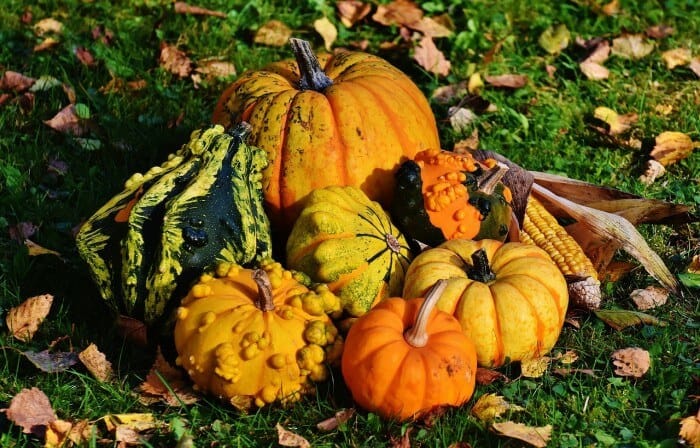
Decorative Pumpkins
Decorative pumpkins are edible, but may not taste as good as their baking counterparts. Many decorative pumpkins are great for crafts, tablescapes, decorating, and carving.
- Hybrid Pam. This popular, small pumpkin is great for crafts like painting and decorating. Hybrid Pams are a semi-vining pumpkin with orange skin and a bright green stem. It grows to around 7 inches in diameter and up to five pounds. This good producer matures in approximately 90 days.
- Crystal Star. Crystal star is a variety of white decorative pumpkin that is great for carving
- Casperita. Casperita is a small, white pumpkin which looks flashy as a decoration. It bears a taste similar to an acorn squash. It is fairly disease resistant and a hardy producer.
- Early Giant. The early giant is an early producer of medium fruits. It is fairly resistant to powdery mildew, making it a great choice for humid areas. This medium sized pumpkin has an elongated uniform and blocky shape. The medium-dark orange fruit can range in size from fourteen to forty pounds, although the average tends to be around twenty five pounds in size. Stems are stocky and the fruit has deep ribs. It is reliable to grow and performs well at farmers’ markets due to its deep color and tall size. The early giant only needs a moderate amount of space and will yield one to two fruits per plant.
- Lumina. The lumina is a beautiful white pumpkin with very edible and sweet flesh which is also pretty for decorating.
- Orangita. The orangita variety of pumpkin is on the small side, weighing in at about 1 ½ pounds and showing off decorative crisp ribs.
- Knucklehead. For an eye catching variety of pumpkin, try growing the knucklehead with its garish warts and green to orange rind. The firm flesh of this variety of pumpkin is great for carving.
- Jack O’Lantern. Jack O’Lantern is a traditional carving pumpkin with a sweet, fine and pale orange-yellow flesh. This pumpkin stores and cooks beautifully, making it great for decorating and eating both. The shape varies from round to oblong. It usually runs nine or ten inches tall and weighs in at ten to eighteen pounds.
Cooking Pumpkins
- Sugar Treat. If you like baking pumpkin pies, try growing the sugar treat pumpkin. This semi-bush hybrid is ideal for pies and matures in 100 to 120 days.
- New England Cheddar. The New England Cheddar variety of pumpkin gets its name because it looks like cheese. This rich, medium sized pumpkin is also great for baking.
- Porcelain Doll. The porcelain doll variety of pumpkin is aptly names for its soft pink color with deep ribs. Its creamy texture makes it great for soups.
- Blue Doll. The Blue Doll has a green exterior with an orange interior. The sweet flesh is great for all kinds of pumpkin recipes.
- Cinderella. For a sweet-flavored pumpkin, try Cinderella. The sweet yellow-orange flesh grows to maturity in eighty four to one hundred days. It gets its name from its globe-shape similarity to Cinderella’s pumpkin carriage. The skin of the pumpkin is smooth and bright orange. It grows up to ten inches in diameter and weighs in at twenty to twenty five pounds. This bush type of vine needs only six square feet of growing space. This type of winter squash does not keep as well as other vine types.
- Mosque de Provence. For a cultural treat, try this variety cultivated in Southern France. The fruits are ribbed, flat, tan, and with moderately sweet flesh. Wedges that look like cheese are sold for cooking in farmer’s markets in France. This variety has a long shelf life and is sometimes called fairytale for its decorative and magical appearance.
- New England Pie. The classic New England pie pumpkin has dark orange skin and ranges in size from four to six pounds. The flesh is dry and stringless but not sweet.
- Marina Di Chioggia. This bumpy squash makes a great fall decoration and wonderful squash pasta. It weighs between six and twelve pounds with blistered skin.
- Jarrahdale. Jarrahdale bears a greenish blue tint and is a medium to large pumpkin, weighing between twelve and eighteen pounds. It has a long storage life with sweet, thick flesh and a drum-like shape. It is great for both eating and decorating.
Jumbo Pumpkins
Jumbo pumpkins are fun to grow and exciting to use for decorating. Jumbos require extra fertilizer and extra space, so plan accordingly.
You may want to remove all but two or three vines so that the plant can focus its energy on producing bigger but fewer fruits. Some gardeners will remove all but two or three fruits as well.
Some prize-winning pumpkin producers claim that feeding milk to your pumpkin will help it to grow larger. To do so, fill a container with milk and punch a small hole in the lid. Run a cotton wick or wicking material through the hole into the milk.
With a sharp knife, cut a small and shallow slit on the underside of the vine of the pumpkin you would like to feed with milk. Place the wick into the opening in the vine, and wrap with gauze to protect the slit. This may increase the potential size of your giant pumpkin.
- Atlantic Giant. The Atlantic giant is a large pumpkin that can grow to 200 pounds. It will take 130 to 160 days to mature.
- Big Max. These large pumpkins can vary in color from pale orange to bright orange. While the average size is around one hundred pounds, these pumpkins can grow up to three hundred pounds. Select one or two fruits per plant and mulch well.
- Big Moon. This large pumpkin holds its shape well and weighs up to a hundred pounds. It will mature in one hundred ten days.
- Dill’s Atlantic Giant. The average size of this variety of pumpkin is 400 to 500 pounds. It grows to maturity in 130 days.
- Prizewinner. This giant pumpkin grows to a heavy weight of two hundred pounds or more. It keeps a lovely, uniform shape and is easy to grow.
Miniature Pumpkins
Miniature pumpkins are great for fall displays, table decorations, craft projects, and can be delicious when baked.
- Jack be Littles. These cute little pumpkins are great for both decorating and eating. Cut off the tops, clean out the insides, and fill with sugar and bake for a sweet side dish or appetizer.
- Wee B. Littles.
- Munchkins.
- Baby Boo.
When to Plant Pumpkins?
Pumpkins will not germinate in cold soil, and the small seedlings are very susceptible to frost. You can directly sow your pumpkin seeds after all danger of frost has passed and the soil is warm and workable.
The soil temperature must be at least 70 degrees, and preferably, 95 degrees. In the northern areas, if you want pumpkins for Halloween, you will need to plant them by the end of May. In more southern areas, you can start your pumpkins as late as July for a Halloween harvest.
Where to Plant Pumpkins
Pumpkins do well in full sun to part shade, so choose a sunny spot in your garden to plant your pumpkins with enough room for them to grow.
Vining pumpkins need space, and some gardeners will choose to plant their pumpkins along the outside edges of the garden so the vines do not overtake the other vegetables.
If you are planting your pumpkins in hills, you want to space those hills five to six feet apart. Place your hills in rows that are ten to fifteen apart, so that you have around fifty to one hundred square feet of space per hill of pumpkins. Mini pumpkins will require less space than larger varieties.
If space is an issue, look for semi-bush or bush varieties of pumpkin. Pumpkins can be grown in large containers or buckets but will need extra feeding and monitoring for moisture.
How to Plant Pumpkins
Pumpkins do best when direct sown into hills in enriched garden soil. The soil in small hills will warm up faster than a flat garden plot. However, if your growing season is short, you can start pumpkins indoors two to four weeks before your last frost date.
Harden off your seedlings before transplanting them in your garden. Plants should germinate within a week. When thinning, take care not to disturb the roots of the pumpkin seedlings you are keeping. Carefully snip off the seedlings you choose not to keep.
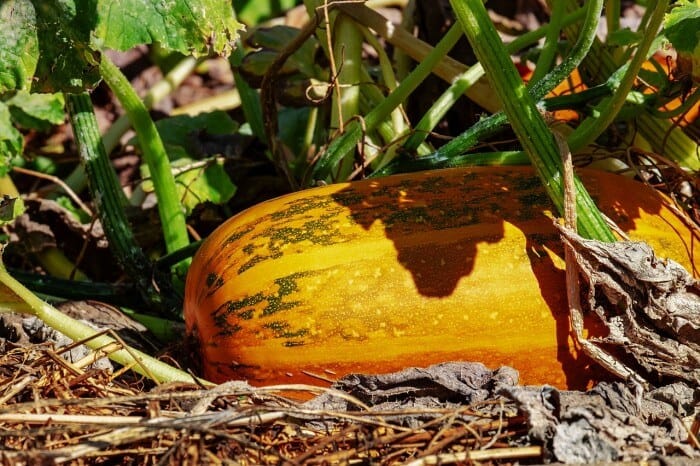
Special Considerations for Growing Them
Pumpkin plants are very tender and do not like their roots disturbed. Be very gentle when weeding, cultivating, or pruning. The less you disturb the remaining plants the better they will grow. Mulching will cut down on the need for pulling weeds.
Pumpkins can rot when exposed to damp soil. To prevent your pumpkins from rotting, place a thick piece of cardboard or scrap of wood under your pumpkins to keep them dry. You can gently turn the pumpkins to encourage even growth, but be very careful not to damage the stem in any way.
Row covers can be used early in the season to protect the tender seedlings from weather and pests, but you will need to remove these covers before flowers emerge in order for pollination to occur. Pests that attack pumpkins are squash bugs, beetles, and aphids.
The first set of flowers to appear on your pumpkin vines are most likely male flowers. The purpose of male flowers is to begin to attract pollinators to the plants, but these flowers will not turn into fruit. Subsequent flowers will be both male and female.
The female flowers will produce fruit when pollinated. You can plant brightly colored flowers around your pumpkins to attract more pollinators to your pumpkin patch. Avoid using pesticides after flowers appear so as not to harm the pollinators.
Pumpkins require heavy feeding. Apply compost or fertilizer regularly to keep vines producing and to grow healthy fruit. Use a high-nitrogen fertilizer early on when seedlings are young. Later, switch to a high phosphorus fertilizer shortly before the blooms begin to appear.
Pumpkins also require plenty of water, up to an inch per week, especially when the fruit is beginning to appear and grow. Avoid watering the leaves and fruit of the pumpkin vine, and concentrate water at the root area.
Mulch will keep moisture in and pests and weeds out of your pumpkin patch. If the leaves and plants are too wet, powdery mildew can occur and damage or kill your pumpkin patch.
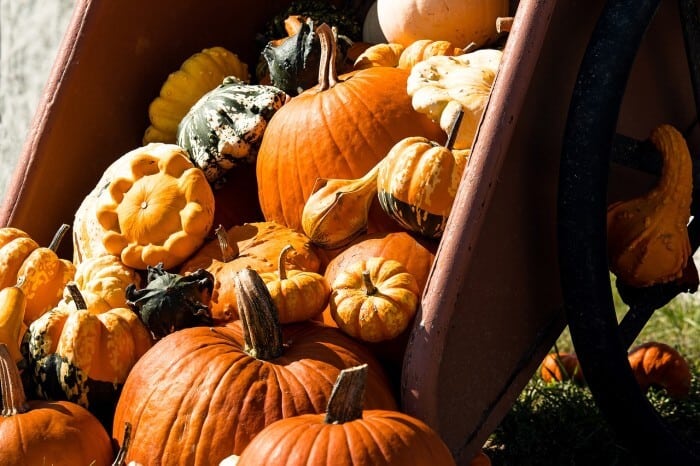
How to Harvest Pumpkins
Do not harvest pumpkins based on their size because immature pumpkins will not last long after being picked. Select your pumpkin variety based on the size you desire, and then harvest them when the pumpkins are fully mature and ripe.
You can tell a pumpkin is ripe when its skin has turned a deep solid color. A ripe pumpkin will sound hollow when thumped, and it will resist being punctured when you press your nail into the rind.
Harvest your pumpkins on a dry day. Wait to harvest your pumpkins until the vines have died back and the rinds are hard. Do not twist or rip the pumpkin off the vine. Instead, use a sharp knife to cut the stem of the pumpkin. Leave plenty of stems intact to slow down the decaying process.
How to Store Pumpkins
Never carry a pumpkin by its stem, always carry it in both hands. Many pumpkins can be stored anywhere from thirty to ninety days when stored properly.
To make pumpkins last longer, wash off the dirt and then gently cleanse the skin with a mild bleach and water solution and then allow it to dry completely.
Pumpkins kept in warmth or sunlight will rot more quickly, so make sure to store your pumpkin in a cool, dark, and dry place.
Do not store pumpkins directly on cement, place them on a board or cardboard instead. Do not stack pumpkins or allow them to touch each other.
Choose pumpkins to store which do not have any blemishes or cuts in the skin. Some experts say pumpkins will last better if they are cured. You can cure your pumpkins by leaving them in the sun in hot weather for seven to ten days.
Cooked pumpkin can be puréed with an immersion blender or food processor and frozen in ice cube trays to use for soups, cooking, and baking.
Or dice the flesh of raw pumpkin and loosely freeze in freezer bags to use in the same ways. Raw or puréed pumpkin can be kept frozen for up to a year without affecting the taste and texture.
Final Thoughts on Growing Pumpkins
If you love gardening and you love pumpkins, then planting, growing, and harvesting your own pumpkins is an easy choice.
If you have plenty of sunshine and space, choose vining pumpkins. If you have less space, choose semi-bush or bush varieties.
Miniature pumpkins will need less space to grow, while jumbo varieties will require much more space, fertilizer, and water. With just a little care and consideration, pumpkins are relatively easy to grow and fun to use.
All varieties are edible either raw or cooked, although cooking and baking varieties taste much better than those cultivated for decorative purposes.
Did you find this article useful? Be sure to PIN IT to Pinterest for later!
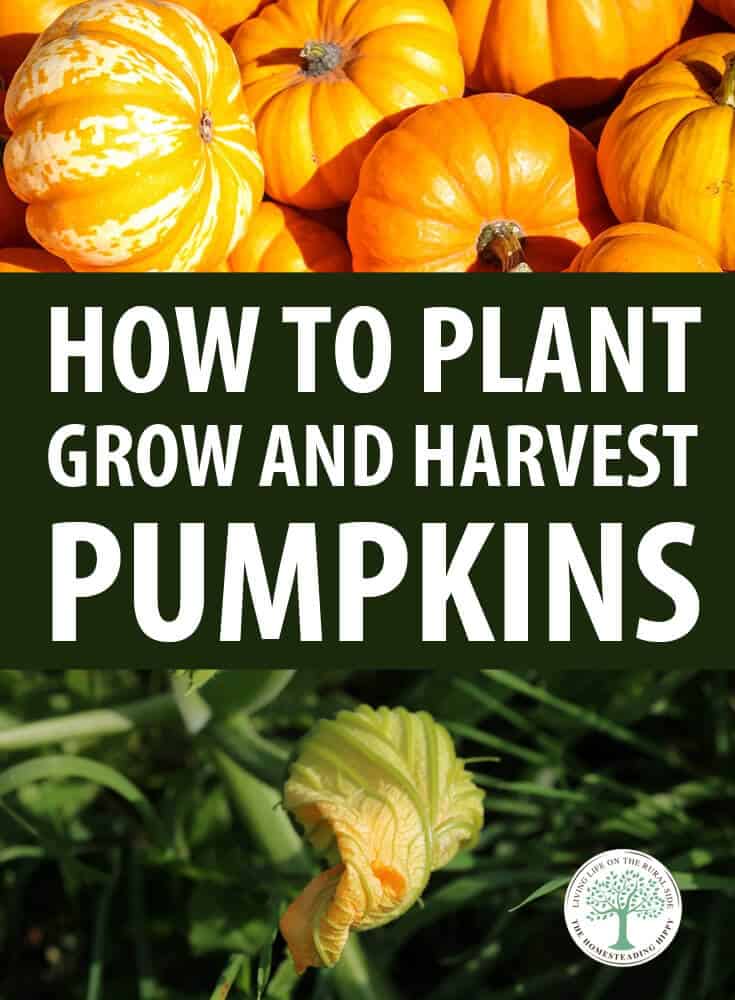

Amanda is a homesteader and a Jesus-loving, mother of 6 toddlers. She’s raising lots of fancy chickens and goats on her small homestead (among other things). Find out more about the team here.
